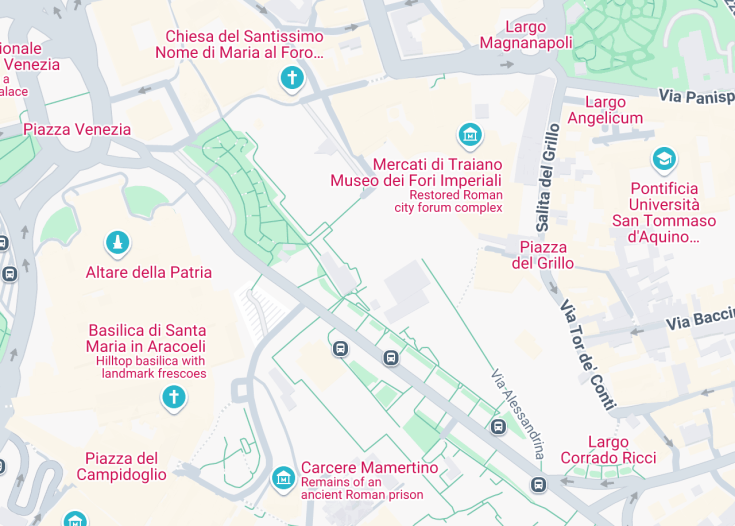Trajan’s Forum, an architectural marvel of ancient Rome, was constructed under Emperor Trajan between 106 and 113 AD. This magnificent complex showcases the grandeur of Roman public spaces, featuring impressive columns, intricate statues, and expansive halls. As a testament to Roman engineering and aesthetics, Trajan’s Forum remains a significant historical site, offering insights into the socio-political life of ancient Rome while attracting countless visitors from around the globe.
To fully experience Trajan’s Forum, consider visiting during the early morning hours. This allows you to enjoy the stunning architecture and rich history in a less crowded environment, providing ample opportunity for photography and contemplation of the site’s magnificence.
When planning your visit to Trajan’s Forum, be sure to allocate sufficient time for exploration. Engage with the informative displays and take a guided tour to appreciate the complexities of Roman life and architecture as you walk through this remarkable historical site.
Trajan’s Forum: A Marvel of Roman Architecture
Trajan’s Forum, located in the heart of Rome, Italy, is one of the most impressive vestiges of ancient Roman architecture. Commissioned by Emperor Trajan around 100 AD, this sprawling complex serves as a testament to the ingenuity and grandeur of Roman engineering. It was the last of the Imperial Fora, showcasing a bustling marketplace alongside stunning basilicas and monumental columns. Visitors marvel at the magnificent Column of Trajan, which narrates the story of Trajan’s victory in the Dacian Wars through intricate reliefs. Today, the Forum attracts tourists with its rich history and impressive ruins, allowing them to step back in time to experience the vibrant life of ancient Rome. A walk through Trajan’s Forum offers a unique glimpse into the ambitions of an empire that shaped Western civilization. Undoubtedly, this site is a must-see for history enthusiasts and casual visitors alike!
Exploring the Attractions of Trajan’s Forum
When visiting Trajan’s Forum, there are numerous attractions to immerse yourself in the splendor of ancient Rome.
The Column of Trajan
This monumental column stands at 38 meters tall and is adorned with a continuous frieze that unfolds the narrative of Trajan’s military campaigns. Visitors can not only appreciate its height but also examine the detailed carvings that depict various moments from the wars, providing an educational experience on Roman military history.
The Markets of Trajan
Known as the world’s earliest shopping mall, the Markets of Trajan comprises a multi-level complex featuring shops and administrative offices. Strolling through its ancient corridors, you’ll feel the vibrant pulse of Roman commerce.
An Interesting Fact about Trajan’s Forum
One fascinating fact about Trajan’s Forum is that it was not just a center for commerce and politics; it also housed a library and a temple dedicated to the Deified Trajan. This blended architectural design highlights the importance of both cultural and civic life in ancient Rome. Moreover, the Forum is notable for its innovative use of concrete, which revolutionized construction practices and has influenced architecture for centuries.
Experience the Majesty of Trajan’s Forum in Rome, Italy
Trajan’s Forum, a remarkable testament to the ingenuity and ambition of ancient Rome, invites visitors to step into a bygone era of glory. This vast complex, built between AD 107 and AD 113, serves as an awe-inspiring showcase of Roman architecture, boasting intricate ruins and towering columns. Visitors can expect to be captivated by its stunning views and intricate details, including the enormous Basilica Ulpia and the splendid column dedicated to Emperor Trajan himself.
The Forum is especially suitable for history enthusiasts, architectural lovers, and students of art, providing insight into the socio-political structure of ancient Rome. As you wander through the remains of shops, temples, and public spaces, the stories of the past resonate, making it a profound experience for all who visit.
For those planning a broader itinerary, the Forum seamlessly fits into a journey that includes the Colosseum and Roman Forum, enabling travelers to absorb the rich tapestry of Roman history in one exhilarating day. An insider tip: consider visiting in the early morning or late afternoon when the light casts a golden hue over the ruins, enhancing the beauty for photographs and quiet contemplation.
Another unique aspect of Trajan’s Forum is its special exhibitions and events held throughout the year. These temporary installations often feature modern art juxtaposed against the ruins or history-themed experiences that provide deeper engagement with the site.
The Best Time to Visit Trajan’s Forum in Rome, Italy
The ideal time to explore Trajan’s Forum lies between April and June or September to October when the weather is pleasantly mild. During these periods, the influx of tourists is manageable, enabling a more serene visit, allowing you to truly appreciate the grandiosity of the site.
Special Events
The Forum occasionally hosts cultural events and art exhibits, particularly in the fall, making this a prime opportunity to witness history and modern creativity intertwined. Watching for these events could enhance your visit significantly.
Accessibility and Limitations
While Trajan’s Forum is a magnificent site, there are some limitations regarding accessibility that visitors should be aware of.
- The terrain can be uneven, posing challenges for those with mobility issues.
- Some areas may have limited access due to ongoing preservation efforts.
Accessibility
Limitations
- Photographs may be restricted in certain areas due to preservation measures.
- Visitor capacity may be limited during peak hours to ensure a pleasant experience.
- Some sections might be closed for restoration, so always check in advance.
Notes to visitors
- Restrooms and limited visitor services are available on-site.
- It’s advisable to wear comfortable shoes as you will be walking on ancient surfaces.
- Guided tours can provide deeper insights but may need advance booking.
General Information
Essential details for your visit to Trajan’s Forum.
Location
Trajan’s Forum is conveniently situated near the bustling heart of the city, accessible through major transport hubs like Termini Station. It’s in proximity to landmarks such as the Roman Forum and the Colosseum, making your travel experience seamless.
Address:
Via dei Fori Imperiali, 00186 Roma RM, ItalyVisiting Information
The Forum can be visited freely without strict closing hours. However, it’s best to arrive in the early morning or late afternoon for fewer crowds and optimal lighting for photography.
How to Reach Trajan’s Forum
Getting to Trajan’s Forum is easy with various transportation options available from the city center.
Car
Visitors can access Trajan’s Forum by car, with parking facilities available nearby for a nominal fee. Additional parking lots are also in the vicinity.
| Route | Distance | Travel time |
|---|---|---|
| From Termini Station | 2 miles (3.2 km) | 10 minutes |
| From Piazza Navona | 1 mile (1.6 km) | 5 minutes |
| From Vatican City | 2.5 miles (4 km) | 15 minutes |
Public Transport
Public transportation also serves the area efficiently. Buses and metro lines lead directly to stops near the Forum.
| Route | Distance | Travel time |
|---|---|---|
| From Termini Station (Metro Line B to Colosseo) | 2 miles (3.2 km) | 15 minutes |
| From Via del Corso (Bus 81) | 0.5 miles (0.8 km) | 10 minutes |
| From Piazza Navona (Bus 30) | 1 mile (1.6 km) | 5 minutes |
Nearby Attractions
Explore these captivating attractions located close to Trajan’s Forum:
- Roman Forum – 1 mile (1.6 km)
- Colosseum – 1.2 miles (2 km)
- Pantheon – 1 mile (1.6 km)
- Piazza Navona – 1.2 miles (2 km)
- Vittoriano Monument – 0.6 miles (1 km)
- Palazzo Venezia – 0.4 miles (0.65 km)
- Capitoline Museums – 0.8 miles (1.3 km)
- Trajan’s Market – 0.2 miles (0.3 km)
- Spanish Steps – 1.5 miles (2.4 km)
- Borghese Gallery – 1.2 miles (2 km)
- Campo de’ Fiori – 0.9 miles (1.5 km)
- Ghetto Ebraico – 0.8 miles (1.3 km)
Common Questions
What are the key features of Trajan's Forum in Rome?
Trajan’s Forum, one of the most impressive imperial fora in ancient Rome, is a monumental complex that showcases the grandeur of Roman architecture and urban planning.
Key features include:
-
The Trajan’s Column, which commemorates Emperor Trajan’s victory in the Dacian Wars, is adorned with spiral bas-reliefs that depict scenes from the battles.
-
The Basilica Ulpia, one of the largest basilicas of the time, served as a public gathering space and displayed grand architectural elements, such as tall columns and intricate decorations.
-
The Market of Trajan, which is often referred to as the world’s oldest shopping mall, contains a series of shops and administrative buildings that reflect the commercial aspects of Roman life.
-
The courtyard and the grand temple dedicated to the Emperor Trajan highlight the forum’s purpose as a center for public life and imperial worship.
-
Architectural styles found throughout the forum blend various influences, showcasing the sophistication of Roman engineering and artistic skills.
Visitors to Trajan’s Forum can appreciate not only these physical structures but also the historical significance they represent within the broader context of Roman civilization.
What historical significance does Trajan's Forum hold?
Trajan’s Forum is not only an architectural masterpiece but also a symbol of the political and economic power of the Roman Empire during its zenith.
Built between A.D. 106 and 113, it reflects Emperor Trajan’s ambitions and successful military campaigns.
The forum served multiple purposes: it was a social hub where citizens gathered, a market for commerce, and a religious center honoring the Emperor. This multifunctionality highlights the complexities of Roman urban life.
Furthermore, the forum’s construction demonstrated the technological and artistic advancements of the time, with innovations in engineering such as vaulted ceilings and the use of concrete.
Trajan’s Column, standing at the center of the forum, not only celebrated military victory but also served as a prophet of Roman propaganda, showcasing Trajan as a benevolent leader. The detailed carvings on the column provide insights into the Dacian Wars, making it a vital historical source for modern historians studying Rome’s military tactics and societal values.
Understanding Trajan’s Forum offers significant insight into the political, economic, and cultural landscape of ancient Rome, and it exemplifies the legacy of one of its most revered emperors.
How was Trajan's Forum constructed?
The construction of Trajan’s Forum, which began under Emperor Trajan and continued through his successor Hadrian, is a remarkable feat of engineering and design that reflects the capabilities of Roman builders.
The building process involved the following stages:
-
Site Preparation: The chosen location was carefully selected in the valley between the Quirinal and the Capitoline hills. Extensive excavation was needed to level the ground and create a foundation suitable for such monumental structures.
-
Material Sourcing: High-quality marble and other materials were sourced from across the empire, ensuring that the buildings would not only be sturdy but also visually stunning.
-
Innovative Techniques: The use of advanced techniques, such as the Roman arch and concrete, allowed for expansive spaces and impressive heights, setting Trajan’s Forum apart from earlier constructions.
-
Artisan Craftsmanship: Skilled artisans were employed for decorative elements, including sculptures, reliefs, and intricate mosaics that adorned the buildings and added to the forum’s splendor.
-
Project Management: The construction required meticulous organization and oversight, with many workers, including engineers, laborers, and artists, collaborating over several years to realize Trajan’s vision.
Ultimately, the successful completion of Trajan’s Forum not only honored the emperor’s legacy but also showcased Rome’s power and influence through its architectural grandeur, setting a precedent for future imperial projects.
What architectural styles can be found in Trajan's Forum?
Trajan’s Forum showcases a synthesis of various architectural styles that reflect the grandeur and sophistication of Roman engineering during the early 2nd century AD.
Key architectural elements include:
-
Classical Roman Architecture: The use of columns, arches, and domes is quintessentially Roman. The columns are often fluted and topped with Corinthian capitals, which convey a sense of elegance and verticality.
-
Rediscovery of Greek Influences: The forum borrows elements from Greek architecture, particularly in the intricate friezes and the general layout, featuring open spaces and monumental structures reminiscent of Greek agoras.
-
Opus Caementicium (Roman Concrete): This innovative material allowed for the construction of vast and sturdy buildings, enabling complex designs such as the grand vaulted ceilings seen in the Basilica Ulpia.
-
Baroque Elements: While predominantly Classical, the ornamentation and attention to detail in some of the sculptures hint at the early influences of Baroque aesthetic that would become more pronounced in later periods.
-
Architectural Innovation: The use of concrete and the development of the dome during this period signify a major advancement in architectural design, influencing future buildings both in Rome and beyond.
This rich tapestry of styles not only served practical purposes in creating functional public spaces but also represented the ideals of Roman civilization—power, beauty, and harmony.
What artifacts can be found at Trajan's Forum?
Trajan’s Forum is home to numerous artifacts that shed light on ancient Roman life, society, and the accomplishments of Emperor Trajan.
Noteworthy artifacts include:
-
Trajan’s Column: The most famous artifact, this monumental column is a detailed and spiraled relief that narrates the Dacian Wars. Various scenes show military tactics, the lives of soldiers, and the interactions between Romans and Dacians.
-
Sculptures and Statues: Fragments of marble statues and reliefs that once adorned the forum can be found, depicting gods, emperors, and allegorical figures that reflect Roman values and culture.
-
Architectural Remnants: Remains of the Basilica and the Market, including foundation stones and structural elements, provide insight into Roman architectural techniques and urban planning.
-
Pots, Tools, and Everyday Objects: Archaeological discoveries in the area include everyday items that give context to daily life in ancient Rome, such as pottery, coins, and other artifacts used in commerce.
-
Inscriptions and Dedications: Stone inscriptions commemorating various dedications to the emperor and detailing important events can be found, offering a glimpse into the political landscape of the time.
These artifacts are not merely remnants of the past; they are crucial to understanding Roman history, culture, and the enduring legacy of Trajan’s reign.

Is Trajan’s Forum in Rome Worth Visiting?
Visiting Trajan’s Forum in Rome is definitely worthwhile for those interested in ancient architecture and history. This iconic site, built in the early 2nd century AD, is not only an impressive testament to Roman engineering but also a window into the past. Walking through the ruins, you can imagine the bustling marketplace and administrative center it once was.
The beauty of the ruins, combined with the rich historical context, makes for an enlightening experience. With stunning columns and carvings, visitors can appreciate the artistry of ancient Roman culture. Furthermore, its location near the Colosseum and other major attractions allows for easy integration into a day of exploration.
For any traveler in Rome, Trajan’s Forum provides a unique opportunity to step back in time and witness the grandeur of the Roman Empire.










